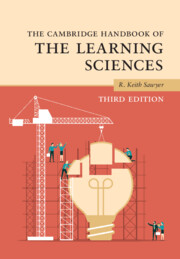Book contents
- The Cambridge Handbook of the Learning Sciences
- The Cambridge Handbook of the Learning Sciences
- Copyright page
- Contents
- Figures
- Tables
- Contributors
- Preface
- 1 An Introduction to the Learning Sciences
- Part I Foundations
- 2 Foundations of the Learning Sciences
- 3 Scaffolding
- 4 Project-Based Learning
- 5 Metacognition and Self-Regulated Learning
- 6 A History of Conceptual Change Research
- 7 Learning in Activity
- 8 Cognitive Apprenticeship
- Part II Methodologies
- Part III Grounding Technology in the Learning Sciences
- Part IV Learning Together
- Part V Learning Disciplinary Knowledge
- Part VI Moving Learning Sciences Research into the Classroom
- Index
- References
4 - Project-Based Learning
from Part I - Foundations
Published online by Cambridge University Press: 14 March 2022
- The Cambridge Handbook of the Learning Sciences
- The Cambridge Handbook of the Learning Sciences
- Copyright page
- Contents
- Figures
- Tables
- Contributors
- Preface
- 1 An Introduction to the Learning Sciences
- Part I Foundations
- 2 Foundations of the Learning Sciences
- 3 Scaffolding
- 4 Project-Based Learning
- 5 Metacognition and Self-Regulated Learning
- 6 A History of Conceptual Change Research
- 7 Learning in Activity
- 8 Cognitive Apprenticeship
- Part II Methodologies
- Part III Grounding Technology in the Learning Sciences
- Part IV Learning Together
- Part V Learning Disciplinary Knowledge
- Part VI Moving Learning Sciences Research into the Classroom
- Index
- References
Summary
In problem-based learning (PBL), students are presented with a driving question that is open-ended, without an obvious linear path to a solution. In PBL children solve authentic real-world problems while engaging in disciplinary-appropriate practices. Rather than memorizing information, students learn while engaged in an authentic process of exploring data, arguments, and explanations, and formulating their own hypotheses and tentative solutions. Students explore the driving question by participating in scaffolded practices that help them to define a problem statement and a path toward a solution. Students create a set of tangible products that address the driving question, supporting collaboration and metacognition. Research shows that PBL promotes student engagement, improves academic learning, and enhances social emotional learning. In particular, PBL promotes science learning for all students, including students who historically have not had access to STEM careers.
- Type
- Chapter
- Information
- The Cambridge Handbook of the Learning Sciences , pp. 72 - 92Publisher: Cambridge University PressPrint publication year: 2022
References
- 10
- Cited by

